New PostgreSQL Deployment: Bring Your Own Cloud
Learn how to setup a fully managed PostgreSQL deployment hosted in your own cloud account through ScaleGrid DBaaS.
Check out our PostgreSQL Hosting page to learn more about the fully managed Bring Your Own Cloud (BYOC) solution.
PostgreSQL Deployment - BYOC Setup
Estimated time to complete: 5 minutes
Create a Cloud Profile
All Bring Your Own Cloud (BYOC) plans must have a Cloud Profile created before you can create your deployment. This process takes only a couple minutes to set up, and you can create one for these cloud providers:
- Setup an Azure Cloud Profile
- Setup an AWS Cloud Profile
- Setup a GCP Cloud Profile
- Setup an Oracle Cloud Infrastructure (OCI) Cloud Profile
- Setup a DigitalOcean Cloud Profile
- Setup a Akamai Linode Cloud Profile
Cloud ProfilesYou must first create a Cloud Profile before creating a PostgreSQL deployment.
Create Your PostgreSQL BYOC Deployment
Let's get started creating a PostgreSQL deployment. After completing the Cloud Profile setup, click on the green "Create a Cluster" button in the pop-up window. You can also create a BYOC PostgreSQL deployment on your PostgreSQL page accessible in the left-hand side menu.

Step 1. New Deployment
- Name: Enter a name for your PostgreSQL deployment using alphanumeric characters.
- Cloud Profile: Your newly created Cloud Profile should be selected by default.
- VM Size: Select your PostgreSQL deployment VM size, from Micro to X4XLarge (this will dynamically scale as you grow!).
- Version: Then, select the PostgreSQL version that you wish to use.
Review this information, then click the green Next button:
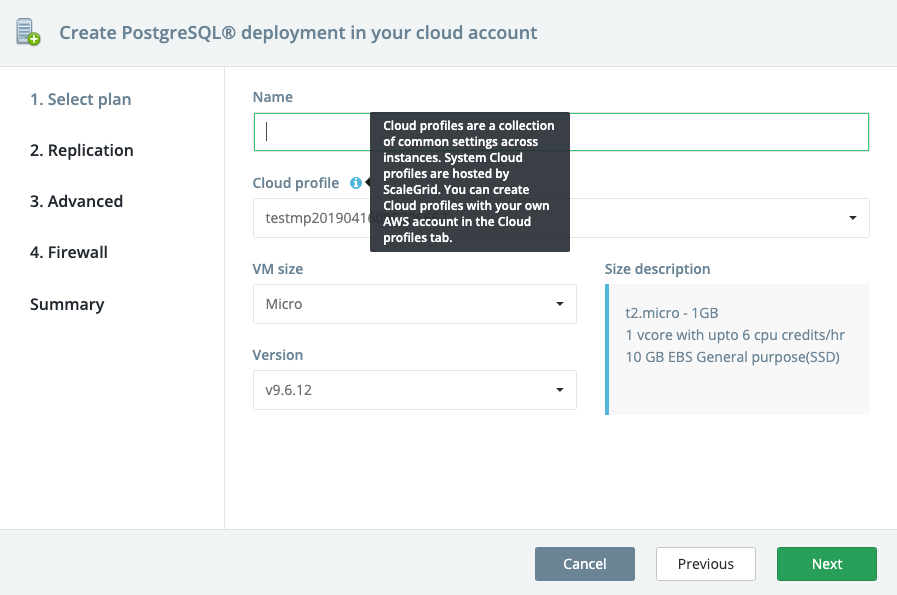
Step 2. Replication
You have the option to setup either a standalone or master-slave configuration for your PostgreSQL deployment.
Standalone DeploymentsIf you do not wish to enable replication for your PostgreSQL Deployment, click next to skip this section.
- Enable replication: Select the "Yes" checkbox to setup a master-slave configuration for high availability.
- Number of nodes: Choose your number of nodes you wish to deploy. The 2+1 Quorum option includes two data-bearing nodes (master and standby) and one voting member, and 3 is for a master-standby-standy configuration.
- Replication strategy: Select the type of replication: Synchronous or Asynchronous. By default, Synchronous is enabled. Learn more about Getting Started with PostgreSQL Streaming Replication.
- Synchronous_commit mode: This specifies whether the transaction commit will wait for WAL (Write-Ahead Logging) records to be written to other servers before a successful commit. Your options are On, Remote Apply, or Remote Commit for a Synchronous replication strategy, and Local or Off for an Asynchronous replication strategy.
- synchronous_standby_names: If you are using a Synchronous replication strategy, you can customize your synchronous_standby_names which specifies a list of standby servers that can support synchronous replication. 1(*) indicates that only one of the standbys is in synchronous mode.
- Review your details, and click Next:
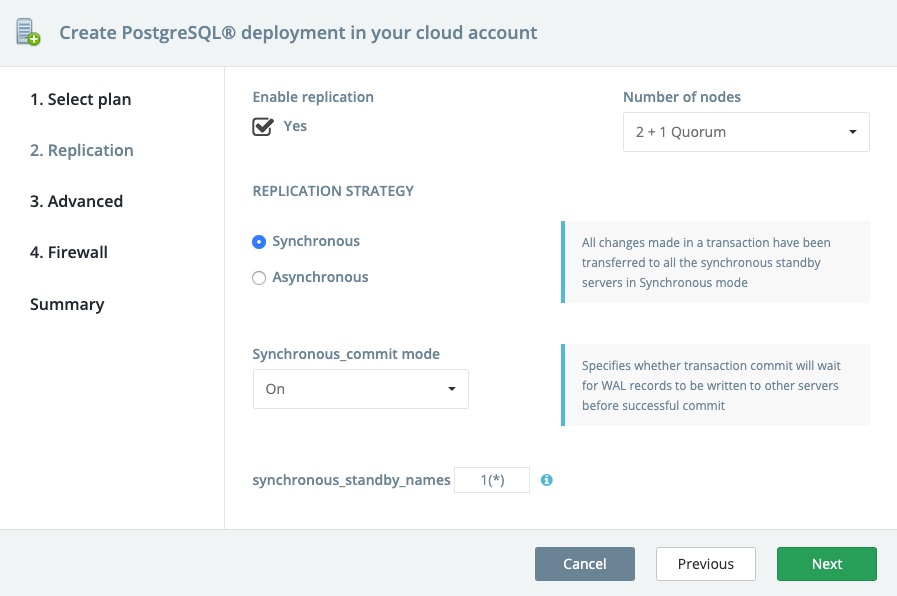
Step 3. Advanced
- Enable SSL: Check the box to enable SSL for your PostgreSQL deployment.
- Encryption at rest: Check the box to enable encryption at rest. When you enable disk encryption, data volumes are encrypted with LUKS (linux unified key setup) encryption.
- Enable PgBouncer: Check the box to enable PgBouncer, a lightweight connection pooler for PostgreSQL.
- Review your configurations, and click the green Next button:
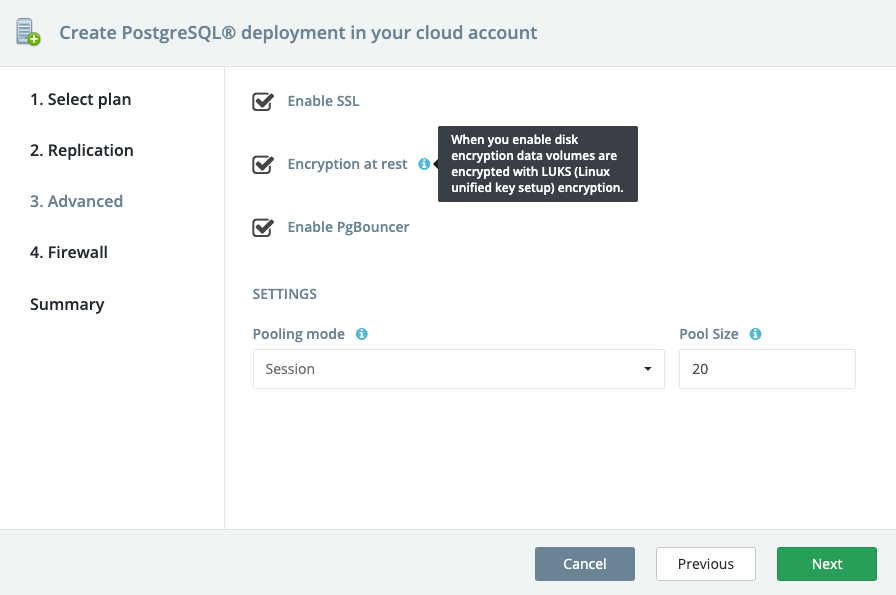
Step 4. Firewall Rules
Firewall configuration is mandatoryFirewall configuration is mandatory since your cluster is exposed to the internet. Enter the list of IP CIDR that will be allowed access.
- Enter the list of IP CIDR that will be allowed to access your cluster one at a time (you can find your own IP at the top of the page).
- Once an IP is entered in the box, click "Add".
- Repeat until you've entered all of your desired IPs (you can also add or remove IPs after your cluster has been created in your Firewall settings on your PostgreSQL cluster details page.
- Review your entries, then click Next:
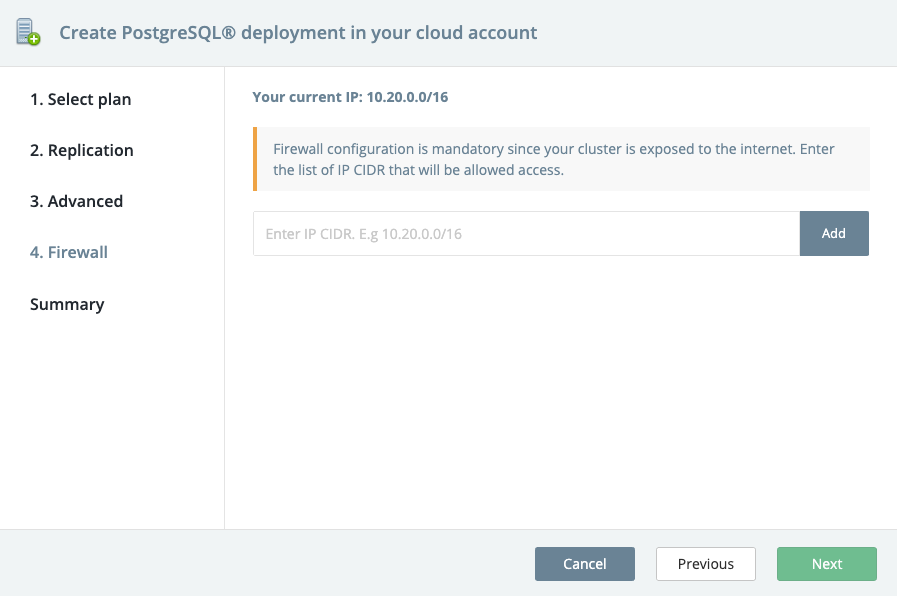
Step 5. Summary
On the last page, review the PostgreSQL deployment details for your BYOC setup, and click “Create”:
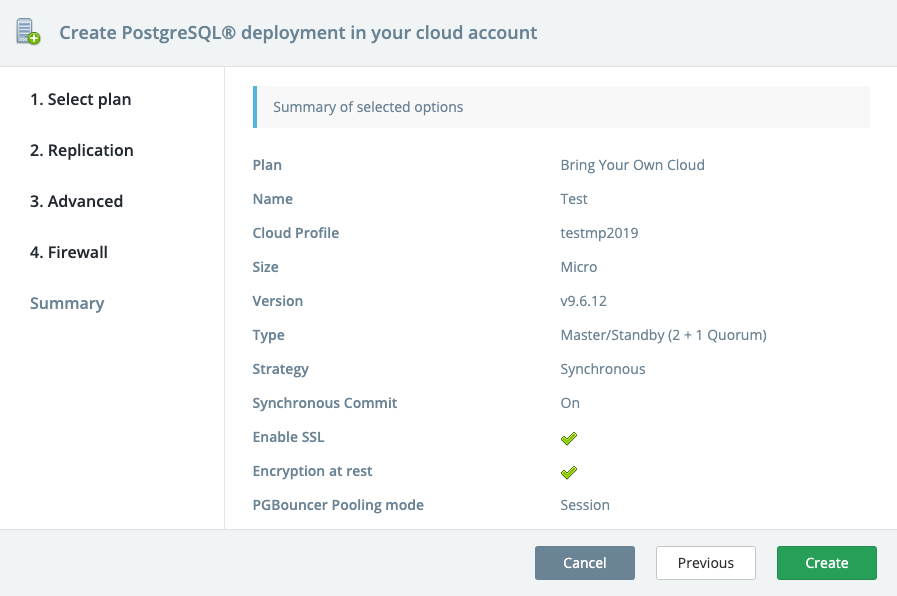
Step 6. Grab Your Credentials
Find detailed instructions with code samples on our Connecting to PostgreSQL page.
Your deployment is now being created! This process takes 15-20 minutes, and the “Creating” status on the right-hand side will change to “Running” once it’s complete. At any point, grab your credentials to connect to your PostgreSQL by going into your new deployment, and then clicking “Show” next to the Credentials section halfway down your overview page.

Updated 8 months ago
